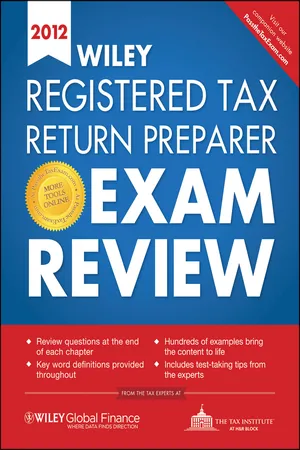
- English
- ePUB (mobile friendly)
- Available on iOS & Android
About this book
The most effective system available to prepare for the new Tax Return Preparer Competency Exam
In recent years, the role of third party assistance in tax return preparation within the United States has become more significant. To acknowledge this trend, the IRS is strengthening partnerships with tax practitioners, tax return preparers, and other third parties in order to ensure effective tax administration that adheres to professional standards and follows the law.
Beginning in 2011, tax return preparers are required to pass a competency test to officially become registered tax return preparers. The Wiley Registered Tax Return Preparer Exam Review Book 2012 has been designed with this in mind and is the perfect guide to help you pass this comprehensive test. The course, complete with extensive exercises and a final exam review, will provide you with a solid foundation on the subject of taxes, and the preparation of an accurate and complete income tax return. Along the way, it covers specific tax issues you need to be familiar with, including tax theory and law; conducting a thorough client interview; and offering tax advice and explanations to clients.
- Helps you zero in on areas that need work, organize your study program, and concentrate your efforts
- Provides paid tax return preparers who are not enrolled agents, attorneys, or Certified Professional Accountants (CPAs) with the individual taxation information they need to pass this competency test
- Covers the major parts of the exam and how to approach each one
Informative and insightful, the Wiley Registered Tax Return Preparer Exam Review Book 2012 will put you in the best position possible to pass this important exam.
Frequently asked questions
- Essential is ideal for learners and professionals who enjoy exploring a wide range of subjects. Access the Essential Library with 800,000+ trusted titles and best-sellers across business, personal growth, and the humanities. Includes unlimited reading time and Standard Read Aloud voice.
- Complete: Perfect for advanced learners and researchers needing full, unrestricted access. Unlock 1.4M+ books across hundreds of subjects, including academic and specialized titles. The Complete Plan also includes advanced features like Premium Read Aloud and Research Assistant.
Please note we cannot support devices running on iOS 13 and Android 7 or earlier. Learn more about using the app.
Information





| Filing status (see Chapter 2 for details) | Age at end of 2011* | 2011 Gross income at least |
| Single | Under 65 65 or older | $9,500 $10,950 |
| Married filing jointly | Both spouses under 65 One spouse 65 or older Both spouses 65 or older | $19,000 $20,150 $21,300 |
| Married filing separately | Any age | $3,700 |
| Head of household | Under 65 65 or older | $12,200 $13,650 |
| Qualifying widow(er) with dependent child | Under 65 65 or older | $15,300 $16,450 |
| *Those born on January 1 are treated as age 65 on the previous December 31. Thus, a person born on January 1, 1947, is treated as attaining age 65 in 2011. | ||
Table of contents
- Cover
- Title Page
- Copyright
- Introduction
- Strategies for Success on the Registered Tax Return Preparer Exam
- Part 1: The Income Tax Return
- Part 2: Income and Assets
- Part 3: Deductions and Credits
- Part 4: Other Taxes
- Part 5: Completion of the Filing Process
- Part 6: Practices and Procedures
- Part 7: Ethics and Circular 230
- Answers to Review Questions
- Appendix: IRS Resources
- Index